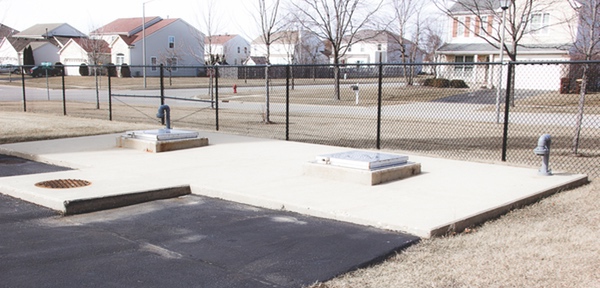In a fast-growing village, few things wear out faster than the water and waste water systems.
The village has about the same water infrastructure that it had back in 1999. In the past 18-plus years, Huntley’s rates have increased very little. When Sun City opened in 1999, the village’s population was less than 3,000. Today, it is about 26,700. While residential growth has slowed in recent years, commercial and industrial developments continue to expand significantly.
When the latest bi-monthly water bills were mailed to all residents in January, they were accompanied by a two-page announcement: Effective May 1, the largest water rate increase in the last two decades will take effect.
“The village’s water and waste water (sanitary sewer) operations are a self-sustaining enterprise that does not receive any property tax or other tax-related income,” the January notice said. The system operates strictly on user fees from residents, including those in Sun City. The village maintains five deep-water wells and 14 waste water lift stations. Plus an extensive infrastructure to support them.

Huntley’s water system is aging and in need of $20 million of improvements in the next 6-15 years. Planned work inclujdes one new well like the one above at Haligus and Kreutzer roads. (Photo by Tony Pratt/Sun Day)
This is the largest rate increase since Sun City opened,” said Cathy Haley, Huntley director of finance.
“Huntley, like most villages, assesses a cost-of-living rate increase annually, which is equal to the Federal Cost of Living Index or 2%, whichever is larger.”
The Sun Day spoke with Haley and Tim Farrell, village public works director, about the village’s water problems. The increase is the result of several factors, Farrell said.
“They are the village’s aging infrastructure, the need for major capital improvements, and steadily expanding governmental regulations and standards. The normal aging process of the infrastructure, which is now 15-20 years old, requires more maintenance and improvements to meet operating needs. In addition, we have more Environmental Protection Agency (EPA) regulations and mandates to implement,” he said.
The village has identified nearly $20 million needed for new capital improvements in the next 6-15 years. Major projects during this period will include $3 million for waste water treatment facility upgrades, $5.3 million for a new water treatment plant, $1.4 million for a new water well, and $3.1 million for a new lift station near the I-90 toll way.
The village is modifying its entire water financing system, as follows:
A new capital and infrastructure fee will start on May 1. A flat bi-monthly fee of $4.50 for water and $4.50 for sewer will be added to bills sent out starting in May.
The minimum charge for water to all residents is based on 4,000 gallons of water and sewer usage. This will be reduced to 3,000 gallons in May.
“This will bring the amount of water a minimum user is paying for water closer to the actual amount of water used, as many minimum bills typically range from 2,000 to 3,000 gallons per bill,” Haley said.
The current rate schedule is $3.02 per 1,000 gallons for water and $3.99 per 1,000 gallons for sewer. Starting in May, residents will pay $3.17 per 1,000 gallons for water and $4.19 per 1,000 gallons for sewer. In the next four years, effective January 1 each year, these rates will increase to $3.33 for water and $4.40 for sewer in 2019, $3.50 for water and $4.62 for sewer in 2020, $3.67 for water and $4.85 for sewer in 2021, and $3.84 for water and $5.09 for sewer in 2022.
Finally, higher rates are coming for irrigation (residents who have automatic sprinkling systems in their yards). This is being established to encourage water conservation, Farrell said. Rates for water use through a secondary irrigation meter will be $6.34 per 1,000 gallons starting in May 2018, $6.66 in 2019, $7.00 in 2020, $7.34 in 2021, and $7.70 in 2022.
Average bi-monthly consumption in Huntley, including Sun City, ranges from 4,000 to 8,000 gallons, Farrell said. Here’s how the new rate will look on water bills starting in May, for 8,000 gallons of consumption: $56.83 currently, $68.63 as of May this year, $71.58 in 2019, $74.67 in 2020, $77.92 in 2021, and $81.32 in 2022.
For bi-monthly bills of 4,000 gallons, these same numbers are $28.79 currently, will be $39.19 starting in May, $40.66 in 2019, $42.21 in 2020, #43.83 in 2021, and $45.54 in 2022.
(In a second report on this subject in the near future, the Sun Day will discuss how Huntley’s current rates compare with those in 16 surrounding communities).




